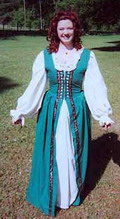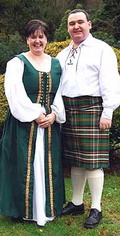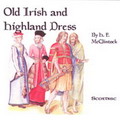8.
Tartan in Ireland.
Contents:
Kilts and Tartan in Ancient Ireland
Indications of Rank Through Number of Colors Employed
The House of Neal and Tartan?
Tartans and Striped Coats
Kilts and Tartan in Ancient
Ireland
Indications are that in Ireland in Ancient Times tartan kilts were
worn.
This may be seen from Ancient Irish depictions, indications in Irish writings,
and here and there archaeological findings.
Indications of Rank Through
Number of Colors Employed
The Custom that we later find of rank being signified by the number of lines on
tartan kilts of the Scottish Highlands found its echo (or precedent) in Ireland
in the number of colors employed.
#According to Keating it was the custom
in ancient times to have one
colour in the form of a slave,
two in the dress of a peasant, three in the dress of a soldier or young lord,
four in the dress of a brughaidh
(land-holder), five in the dress of a district chief, six in the dress of an
ollamh
and in that of a King and Queen.#
#Dwelly
(Gaelic Dictionary - published 1901) writes (under
breacan
[i.e. tartan in Gaelic])
Parti-coloured cloth was used by
the Celts from earliest times, but the variety of
colours
in the breacan
was greater or less according to the rank of the wearer. That of the ancient
kings had seven colours,
that of the druids six, and that of the nobles four.#
Extracts from:
A (much) Smaller Social History of
Ancient Ireland
by P.W.
JOYCE, M.A., LL.D., T.C.D.;
M.R.I.A.
Chapter XVIII - Dress and Personal Adornment - Dress
http://www.alia.ie/tirnanog/sochis/xviiib.html
#King Domnall,
in the seventh century, on one occasion sent a many-coloured
tunic to his foster-son Prince
Congal: like Joseph's coat of
many colours.#

|
#We are told in our legendary history
that exact regulations for the wearing of
colours
by the different ranks of people were made by King
Tigerumas
[Teernmas]
and by his successor, many centuries before the Christian era - a slave was to
be dressed in clothes of one
colour; a peasant or farmer in
two; and so on up to a king and queen and an
ollave
of any sort: all of whom were privileged to wear six.
#The kilt - commonly falling to the knees - is very frequently met with on the
figures of manuscripts, shrines, and crosses, so that it must have been very
much worn both by ecclesiastics and laymen. It appears in a very decided form in
the eleventh-century illustration given here (fig. 120).
|
The House of Neal and
Tartan?
At about the same time (i.e. in the 1500s CE) as we hear reports of tartan dress
in the Western Isles and Highlands of Scotland archaeological finds indicate the
presence of tartan type dress in Northern Ireland, especially in Donegal and
Sligo (as reported by Clifford Smyth, "Titanic Titans", see below.).

|
A piece of woollen tartan cloth dating from ca. 230 CE(?) was found at Falkirk in North Central Scotland.
Despite this find, it is often assumed that the use of tartan as we know it reached Scotland from Ireland together with
the Scottii. Some scholars dispute this pointing out that if such was the case
we would have to explain how tartan took root in Scotland whereas in Ireland
they forgot about it!
Nevertheless we have illustrations from old Irish
manuscripts as in the one from the 1000s CE shown above. We also have Irish finds from Donegal and Sligo
dating perhaps from the 1500s CE. The populations of Donegal and Sligo according
to DNA studies still have the highest concentrations of descendants of Neal (ca. 20%)
in existence. In the Highlands of Scotland the proportion reaches ca. 12%.
Incidentally in Sligo there is also to be found the highest proportion of
red-heads in Ireland or anywhere else. Scotland also benefits from a high
proportion of redheads.
|
The Irish Provinces of Donegal and Sligo were probably part of ancient Dalriada that was ruled over
by the Sons of Neal. Dalriada encompassed parts of both Northern Ireland and Western Scotland.
Those areas in Scotland
where tartan
appeared at first were the former regions of Dalriada that the House of Neal had
ruled over. There may be a link between the two?
Despite the above,
Concerning Ireland it must still be admitted that the earliest reported dress of the Irish
was of a saffron (yellow-orange similar to the background-color of these words) fabric and not a tartan one! Saffron-Yellow i.e. light orange!), not green, was the original national color of
Ireland.
The Irish did not often (if at all) wear tartan in historical times
whereas in the Western Isles and coast of Scotland from the time that detailed
reports are available the inhabitants are described as wearing tartan type
designs.
Tartans and Striped Coats
Our understanding is that the Tartan served as a mark distinguishing area of residence, tribal allocation, along with rank and status of the wearer.
This is borne out by the sources. We also feel that in addition to the tartan design (whether in an intricate form or a simple checkered pattern) different colored lines or stripes were sometimes employed for the same purpose.
A possible example may be found from this 1200s CE depiction of important churchmen from the region of Cavan in northeast Ireland to the south of Ulster.
Source of the picture:
A (much) Smaller Social History of Ancient Ireland by P.W. JOYCE, M.A., LL.D., T.C.D.; M.R.I.A.
http://www.alia.ie/tirnanog/sochis/xviiia.html
#The two figures given here, both ecclesiastics from the shrine of St. Maidoc, thirteenth century#
|

|
A High King of all Ireland (Conaire Mor, ca. 20 BCE) is described in a traditional source (Leabhar na h-Uidhre ca. 1100s CE) as wearing a linen kilt with striped silken
boarders. The stripes may indicate rank.
Continued on Page 8.
|
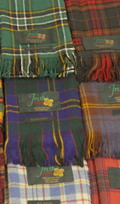
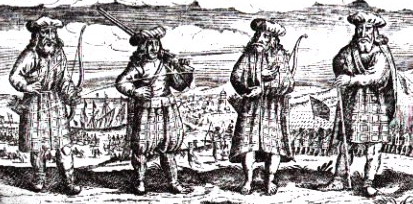
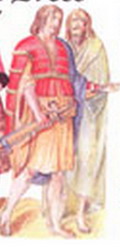


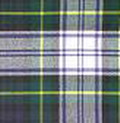


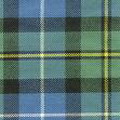

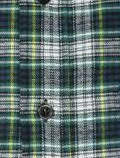
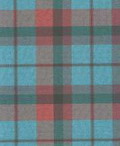
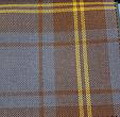


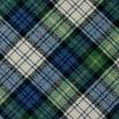



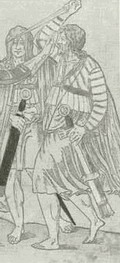 Irish Soldier ca.1500s
Irish Soldier ca.1500s
